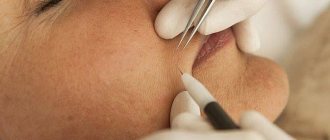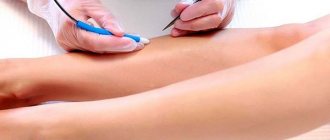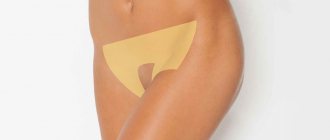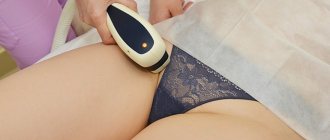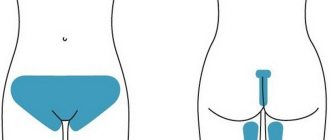Electrolysis is an effective method of removing excess hair for a long period of time. The name of the procedure is due to the principle of its implementation: hairs are removed using electric current. Through a sensor-electrode it enters the hair, heats and destroys its shaft, bulb and papilla. The technique involves a targeted approach, that is, processing each hair separately, which is especially successful when it is necessary to work with small problem areas.
Classification of procedures
Electrolysis is divided into several independent areas, differing in the type of devices used and electric current. Thus, types of hair removal can be determined depending on the electrode:
- The tweezer sensor captures each hair, passes current through it and removes it according to the classical principle. This solution is considered painless and suitable for working with sensitive skin.
- Sensor - needle . The most popular and frequently practiced method. A needle is inserted into the hole from which the hair grows, an electric current is applied, and then the hair falls out on its own. The sensor can be made of a medical alloy or gold, and even have a Teflon coating.
Sensor - tweezers
Sensors - needles
Of course, the most commonly used classification of the procedure involves taking into account various types of electrical currents. Thus, it is customary to distinguish the following most popular types of electrolysis.
Thermolysis
It is carried out on the basis of high frequency alternating current. It is distinguished by extremely rapid destruction of the follicle, due to which a high speed of manipulation is achieved. It must be taken into account that the effectiveness of such a technique is directly related to the qualifications of the cosmetologist.
Electrolysis
Destroys hairs by forming an electrochemical process based on galvanic current. This method is suitable for destroying even damaged follicles, but requires a significant amount of time.
Bland
It is a symbiosis of thermolysis and electrolysis. He has absorbed their best positive aspects, thanks to which he receives positive reviews from professionals.
Flash (advanced thermolysis)
Due to its characteristics, it has a less painful effect, but the final results are again determined by the skill and skill of the specialist.
Overview of electrolysis equipment
Depil-Plus 13 Mhz is designed for salon use. Received excellent reviews from craftsmen and clients
The recognized leader in the segment is the Spanish brand ROS'S; its equipment for electrolysis has received positive reviews from professionals and clients. The palm goes to the Depil-Plus 13 Mhz model, which combines fairly high performance and low cost.
The device can operate effectively in electrolysis, thermolysis, blend and flash modes. Not least popular is the function of air ozonation, which provides antibacterial protection and promotes the healing of microwounds.
Needle electroepilator "Polly"
Depil plus-2 differs from Depil-Plus 13 Mhz by the presence of a cooling system, which provides a fairly high level of pain relief. If you are looking for a classic needle-type electric epilator for the salon without additional functions, pay attention to the Kh-12 Plus.
Main stages of the procedure
Electrical hair removal is a very painstaking and time-consuming technique. One session can take from 10 minutes to several hours.
The procedure begins with mandatory anesthesia. Anesthesia during electrolysis can be carried out either by an injection or by a special surface anesthetic cream. Then the patient takes a comfortable position and takes a passive electrode in his hand, the active sensor is located by the cosmetologist, and it is with the help of it that every hair is removed.
Upon completion of the manipulations, a prerequisite is the application of a sedative that has an antiseptic effect.
Video: how electrolysis works
A positive effect can only be achieved by completing the full course. Reviews from patients indicate that visible changes occur after the first session, but they do not bring 100% results.
On average, a full course involves from 5 to 8 procedures (less often - more or less, this can only be determined by a cosmetologist during a personal meeting). The break between sessions is approximately 45 - 60 days, and if necessary can be reduced to a month.
Back in time
Considering the electrolysis procedure, perhaps, it is worth starting with who, when and why the method of getting rid of hair using current was invented. Like many things in our world, electric hair removal is an accidental and unplanned invention.
For the first time, current was used for hair removal more than a century ago in ophthalmology, it was designed to solve the problem of ingrown eyelashes. Five years later, the technique began to be used for non-medical purposes - Paul M. Chris made the galvanic method so popular that cosmetology centers in America and England bore his name.
1945 is considered the time of creation of the first universal device, which combined two types of current; after 3 years, the know-how received a patent and began to bear the proud title of a blend device for electrolysis.
In the 50s, electric hair removal became the second most popular cosmetic method of getting rid of unwanted hair, second only to the good old razor.
In the 60s, electrolysis, despite the duration of the procedure and high cost, became the most popular method of hair removal.
A modern device for electrolysis is a device completely controlled by a computer. One movement changes the strength and frequency of the current, the human factor is almost completely excluded as a cause of undesirable consequences.
How to properly organize rehabilitation?
Skin care after electrolysis should be performed on a regular basis. It is imperative to use antiseptics, for example, alcohol-containing solutions or Miramistin. The preparations are applied to a clean cotton pad and used for further treatment of the skin 3 - 4 times a day at equal time intervals.
If necessary, it may be necessary to use anti-inflammatory and healing compounds (Bepanten, Panthenol and others ointments). They are used for burns and severe redness of the dermis to relieve inflammation, soothe damaged tissues and provide additional hydration.
On average, rehabilitation lasts up to 14 days, but for many patients it ends much faster. In addition to using the special tools described above, it is necessary to adhere to the following standard restrictions, namely:
- Do not go out in the sun without special protective cosmetics.
- Do not visit solariums, saunas and baths.
- Avoid swimming in pools and open water.
- Limit physical activity so as not to provoke active sweating.
- Minimize any mechanical impact on the treated area (it is strictly forbidden to comb the resulting crusts at the site of the removed hairs).
Video review and recommendations for electrolysis
Possible complications
Consequences of electrolysis performed in violation of technology
- Swelling, edema, itching and pigmentation after electrolysis (disappear 3-4 days after the session);
- Hyperpigmentation appears as a result of violation of recommendations and sunbathing (solarium) in the first two weeks after the procedure. Before removing stains after electrolysis, consult a cosmetologist; you may need a course of chemical peels and the use of special cosmetics with whitening ingredients.
Skin healing after electrolysis is facilitated by the use of creams and ointments, for example, Bepanten (price - from 350 rubles)
- Burns and scars are considered medical errors. If you fall into the hands of a non-professional, use anti-inflammatory, wound-healing drugs (Panthenol, Olazol, Levomikol, Bepanten, Contractubex), as well as creams based on chamomile, calendula and aloe.
You can use homemade calendula cream as a healing and moisturizing agent.
Negative consequences of electrolysis
Unfortunately, even such an effective procedure is often accompanied by various side effects. Some of them are a natural reaction of the body to external interference, while others can be quite dangerous and indicate errors that occurred during exposure. Thus, the following manifestations are considered normal:
- Swelling.
- Local redness.
- Mild itching.
- Formation of crusts and peeling of the skin.
If these side effects occur, it is recommended that you do nothing. Try to wait out the rehabilitation period and follow a number of simple recommendations; you do not need to see a doctor for additional help.
Skin after electrolysis
Of course, complications can be more pronounced. Usually they are associated with the individual characteristics of the patient’s body, low professionalism of the cosmetologist, neglect of safety precautions or contraindications. These include:
- Hyperpigmentation (formation of dark spots on the skin).
- Spread of infection and formation of hidden inflammations.
- Burns (their cause is medical error or skin hypersensitivity).
- Scarring.
- Hematomas.
If you observe any of the listed complications, or existing side effects do not go away within 3 to 5 days, it is recommended to visit a cosmetologist for a second consultation and prescription.
Comparison of electrolysis with other methods
If you compare electrolysis with other methods of hair removal, you get a fairly effective method that can get rid of both dark and light, gray and red hairs. In terms of price, it wins the battle with photo and laser hair removal, but loses the battle with sugaring and waxing .
It is worth noting the fact that after bioepilation the skin becomes smooth due to the effect of light peeling; unfortunately, exposure to electric current can result in redness of the skin and even the formation of bruises.
Main contraindications
Electrical hair removal has a fairly large number of restrictions on its implementation, which is direct evidence of the seriousness of such an intervention. Contraindications:
- pregnancy and lactation;
- exacerbation of chronic diseases;
- increased body temperature and decreased immunity;
- the presence of implanted gold threads, pacemakers, intrauterine devices;
- exacerbation of skin diseases, the presence of open wounds and cuts in the area subject to treatment.
Burns after electrolysis, immediately and after a few days
Prices
How much does electrolysis cost? Formation of prices is a rather complex process that takes into account many additional factors. The unit of measurement in this case is a minute, the cost of which can be either 10 or 50 rubles. This is explained by the presence of several methods, the use of various instruments, the classification of a specialist, and the availability of various additional services. If you still want to know the approximate costs of the procedures, the information in the table below may be useful to you.
| Zone | Upper lip | Bikini | Legs | Chin |
| Cost (rubles) | From 1000 | From 5000 | From 9000 | From 1000 |
Conclusion
Now you know what electrolysis is - blend method, electrolysis and flash, all that remains is to choose the appropriate method and enjoy smooth skin, and the video in this article will tell you a little more about the procedure.
Did you like the article? Subscribe to our Yandex.Zen channel
Text \ Photo Ekaterina Posted 12/07/2015
0
share:
To favorites
To print
If you want to thank, add clarification or objection to the author - add a comment!
Currently being discussed:
- Lyubov Burkina
20.08.2018
What hair color should I choose? Please give me some advice. I don't know which one I have...
- I
19.08.2018
I had eyelash extensions for 6 months and took a break. After 3 months I increased it again...
- Vasilisa
18.08.2018
Cool hairstyle
18.08.2018
Hi, can I dye my bleached hair (currently red) bright purple...
16.08.2018
Hello! I am a dark girl with black eyes. I want to dye my hair dark...
15.08.2018
The photo shows young beauties. Can older ladies have their eyebrows done? Age...
Comments »
Photos before and after
Photos before and after electrolysis of shoulders
Photos before and after electrolysis of legs
Photos before and after electrolysis of armpits (extremely rare)
Popular questions about the procedure
Is electrolysis suitable for men?
Removing excess vegetation using electric current is suitable for both men and women. However, many experts note that representatives of the stronger sex will not be able to count on obtaining a permanent or even long-term effect, due to the characteristics of their hormonal levels. On average, a solution to a problem for representatives of the stronger sex is available for a period of six months to two years.
Is electrolysis harmful? Why is the procedure not performed during pregnancy?
The procedure is absolutely safe for humans and when performed by professionals does not cause any serious complications for the patient, however, it is still not recommended to carry it out while the baby is waiting. This is explained by the increased sensitivity to pain in the female body and the constantly changing hormonal levels.
How long does last ?
Provided the endocrine system is functioning normally, the positive effect of the procedure lasts virtually for a lifetime; in rare cases, rare hairs begin to grow only after 5–6 years.
Is electrolysis performed in summer?
Electrical hair removal can be carried out at any time of the year, subject to the recommendations of the preparatory and rehabilitation period.
In which areas should you not remove hair using electrolysis?
Manipulation is possible on any part of the body or on the face, however, electrolysis of the armpits is strictly not recommended due to the presence of a significant number of lymph nodes under the skin.
Which areas are most often treated and why?
This procedure is suitable for almost any area, however, since it involves a targeted effect, its implementation is more often practiced for the correction of small areas. At the same time, hair removal on the legs, back and arms is often carried out.
How often do complications occur after the procedure?
After exposure, temporary side effects are almost always observed, which do not pose a serious danger to the patient's health. In rare cases, you can find reviews about complications caused by violation of safety precautions during hair treatment or neglect of mandatory contraindications.
What is the average price per session? How much will the full course cost?
The cost of manipulations is determined by the amount of time spent. One minute is usually valued in the range from 10 to 50 rubles. It is possible to specify prices in more detail only after studying more detailed information. See the table above for approximate prices.
How often can I visit a specialist for electrolysis?
A repeat session is scheduled approximately 5 - 8 weeks after the first visit to a specialist.
Hair: definition, structure, growth phases
Hair is an epidermal thread-like structure distributed over almost the entire surface of the body. Each hair consists of a hair follicle (bulbus pili), located inside the hair follicle, and a shaft that protrudes upward above the surface of the skin. The hair papilla area is filled with connective tissue and contains blood vessels that nourish the growing hair (Fig. 1).
Rice. 1
The dermal papilla is responsible for controlling the hair growth cycle and is considered the growth center of each hair. Elimination of the papilla is the main goal of hair removal systems. A second structure, the bulb, has recently been identified as the source of cell growth.
There are a number of factors that affect human hair growth - age, ethnicity, medications, hormonal levels and body part - and differences can vary in length, thickness, color and depth. However, medical research has standardized the phases of hair growth and the duration of each phase in a complete cycle.
The first phase is anagen. This is an active growth phase that can last several weeks: hair grows as a result of the activity of germinating cells and contains a large amount of melanin. The follicles gradually grow towards the epidermis, while the bulb enlarges.
The second phase is catagen. In this phase, melanocyte and mitotic activity stops, the follicle retracts, the bulb separates from the papilla, although it is still connected by the epithelial notochord, and slowly migrates towards the dermis. This lasts about two weeks, during which the hair not only stops growing, but is also “pushed out.”
The third phase is telogen. The bulb continues to retract and moves towards the surface of the hair canal until it falls out. New hair can coexist with the previous one in this phase, and, as a result, the open follicle is rarely empty (Figure 2).
Rice. 2
